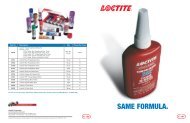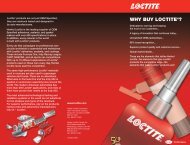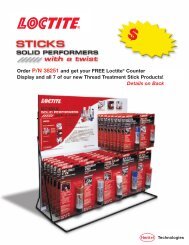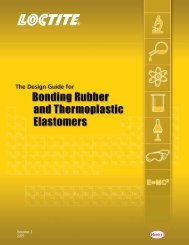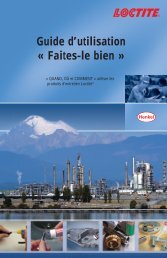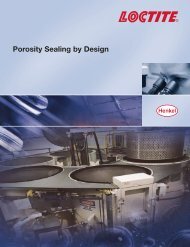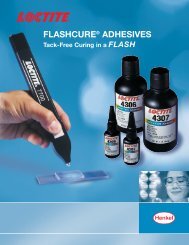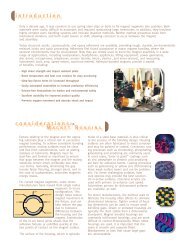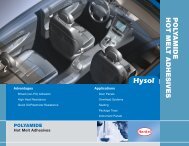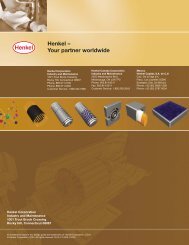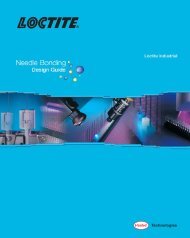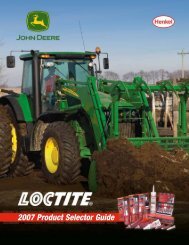Volume 4 - Loctite.ph
Volume 4 - Loctite.ph
Volume 4 - Loctite.ph
Create successful ePaper yourself
Turn your PDF publications into a flip-book with our unique Google optimized e-Paper software.
Determining The Test MethodThe lap shear test method ASTM D1002 is typically used todetermine adhesive shear strengths. However, because it wasdesigned for use with metals, it has several serious limitations whenevaluating plastics. For example, because plastics have much lowertensile strength than metals, the plastic lap shear specimens aremuch more likely to experience substrate failure than the metal lapshear specimens. This makes the comparative analysis of differentadhesives on a plastic very difficult because many of the adhesiveswill achieve substrate failure, rendering it impossible to identify theadhesive best suited for that material. Another major disadvantageto using the lap shear test method is that because plastics havemuch lower modulii than metals, they deform more during testing,which introduces peel and cleavage forces on the joint.Consequently, the lower the modulus of the plastic, the more it willdeform under load, and the less representative the experimentalshear strength will be of the actual shear strength which shouldhave been achieved on that material.Due to these limitations, a block shear test method (ASTM D4501) waschosen. Since block shear testing places the load on a thicker sectionof the test specimen, the specimen can withstand higher loads beforeexperiencing substrate failure. In addition, due to the geometry of thetest specimens and the block shear fixture, peel and cleavage forces inthe joint are minimized.LimitationsWhile the bond strengths in this guide give a good indication of thetypical bond strengths that can be achieved with many plastics, aswell as the effect of many fillers and additives, they also face severallimitations. For example, while the additives and fillers were selectedbecause they were believed to be representative of the mostcommonly used additives and fillers, there are many types of eachadditive and filler produced by many different companies, and differenttypes of the same additive or filler may not have the same effect onthe bondability of a material. In addition, the additives and fillers weretested individually in this guide, so the effect of interactions betweenthese different fillers and additives on the bondability of materialscould not be gauged.Another consideration that must be kept in mind when using this datato select an adhesive/plastic combination is how well the block sheartest method will reflect the stresses that an adhesively bonded jointwill see in “real world” applications. Adhesively bonded joints aredesigned to maximize tensile and compressive stresses, and tominimize peel and cleavage stresses, so the magnitude of the formertwo are generally much larger than the latter two. Thus, the shearstrength of an adhesive is generally most critical to adhesive jointperformance, but since all joints experience some peel and cleavagestresses, their effects should not be disregarded.Finally, selecting the best adhesive for a given application involvesmore than selecting the adhesive which provides the highest bondstrength. Other factors such as speed of cure, environmentalresistance, thermal resistance, suitability for automation, and price willplay a large role in determining the optimum adhesive system for agiven application. It is suggested that the reader refer to the chapterswhich explain the properties of the various adhesives in greater detailbefore choosing the best adhesive for an application.Although there are some limitations to the degree the informationprovided in this guide can be extrapolated, the data contained hereshould be invaluable in helping the end user quickly make comparativeevaluations of the bond strengths that various adhesive/plasticcombinations provide. Once the most promising combinations ofadhesives and plastics have been identified, it is important that testingbe performed on assemblies to insure that they will meet or exceed allperformance requirements.The <strong>Loctite</strong> ® Design Guide for Bonding Plastics, <strong>Volume</strong> 4 85



